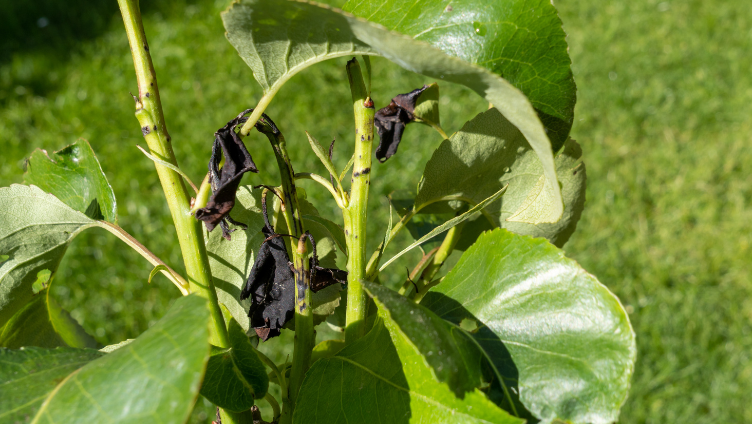Fire blight is a bacterial disease caused by Erwinia amylovora that affects pear trees (and other members of the rose family, like apples). It spreads quickly, especially in warm, wet conditions, and can cause significant damage if not managed properly. Fire blight is often a concern in East Texas, and below is a comprehensive approach to identifying and managing fire blight:
Steps to follow:
1: Identify the Symptoms
-
- Look for: Blackened, wilted leaves and blossoms that appear “scorched” (hence the name “fire blight”).
- Check branches: Infected twigs and branches may turn dark brown or black and bend into a “shepherd’s crook” shape.
- Inspect the bark: Sunken, discolored cankers may form on branches or the trunk, sometimes oozing a sticky, amber-colored liquid.
- Timing: Symptoms often appear in spring during bloom or shortly after.
2: Gather Tools
-
- Pruning shears or loppers (sharp and clean).
- A disinfectant (e.g., 70% rubbing alcohol, 10% bleach solution, or Lysol).
- Gloves (optional, for hygiene).
- A bucket or bag for collecting infected material.
- (Optional) A copper-based bactericide or streptomycin spray (check local regulations for availability).
3: Prune Infected Areas
-
- When to prune: Act quickly during dry weather, ideally in late winter or early spring when the tree is dormant, or as soon as symptoms appear during the growing season.
- How to prune: Cut at least 12-18 inches (30-45 cm) below the visible infection into healthy wood. Look for a clear transition from discolored to healthy tissue.
- Sterilize tools: Dip or wipe your pruning tools in disinfectant between each cut to prevent spreading the bacteria.
- Dispose properly: Collect all pruned material in a bag or bucket and burn it (if permitted) or dispose of it off-site. Do not compost infected debris.
4: Clean Up Around the Tree
-
- Remove fallen leaves, fruit, or twigs beneath the tree, as they may harbor bacteria.
- Avoid overwatering or letting water pool near the trunk, as fire blight thrives in moist conditions.
5: Apply Treatments (If Necessary)
-
- During dormancy: Spray a copper-based fungicide/bactericide on the tree in late winter or early spring before buds swell to reduce bacterial populations.
- During bloom (if active infection): In some regions, streptomycin (an antibiotic) can be applied during flowering to protect blossoms, but this is less common and may require professional guidance. Check with your local agricultural extension service.
- Note: Overuse of chemicals can lead to resistance, so use sparingly and follow label instructions.
6: Prevent Future Infections
-
- Choose resistant varieties: If planting new trees, select fire blight-resistant pear cultivars like ‘Harrow Sweet’ or ‘Moonglow.’
- Avoid over-fertilizing: Excessive nitrogen promotes lush, susceptible growth.
- Prune for airflow: Thin the canopy annually to improve air circulation and reduce humidity around branches.
- Monitor weather: Be proactive during warm, wet springs, as these conditions favor fire blight spread.
7: Monitor and Repeat
-
- Regularly inspect your pear tree, especially after rain or hail (which can create entry wounds for the bacteria).
- If new symptoms appear, repeat the pruning and cleanup process immediately.
